学术论文写作报告(英文版)
- 格式:docx
- 大小:11.21 KB
- 文档页数:2
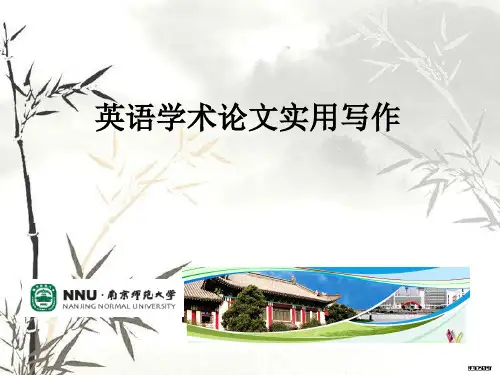
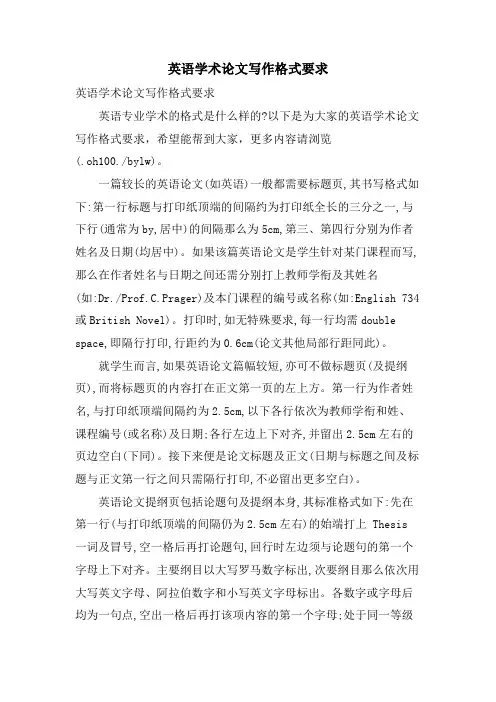
英语学术论文写作格式要求英语学术论文写作格式要求英语专业学术的格式是什么样的?以下是为大家的英语学术论文写作格式要求,希望能帮到大家,更多内容请浏览(.oh100./bylw)。
一篇较长的英语论文(如英语)一般都需要标题页,其书写格式如下:第一行标题与打印纸顶端的间隔约为打印纸全长的三分之一,与下行(通常为by,居中)的间隔那么为5cm,第三、第四行分别为作者姓名及日期(均居中)。
如果该篇英语论文是学生针对某门课程而写,那么在作者姓名与日期之间还需分别打上教师学衔及其姓名(如:Dr./Prof.C.Prager)及本门课程的编号或名称(如:English 734或British Novel)。
打印时,如无特殊要求,每一行均需double space,即隔行打印,行距约为0.6cm(论文其他局部行距同此)。
就学生而言,如果英语论文篇幅较短,亦可不做标题页(及提纲页),而将标题页的内容打在正文第一页的左上方。
第一行为作者姓名,与打印纸顶端间隔约为2.5cm,以下各行依次为教师学衔和姓、课程编号(或名称)及日期;各行左边上下对齐,并留出2.5cm左右的页边空白(下同)。
接下来便是论文标题及正文(日期与标题之间及标题与正文第一行之间只需隔行打印,不必留出更多空白)。
英语论文提纲页包括论题句及提纲本身,其标准格式如下:先在第一行(与打印纸顶端的间隔仍为2.5cm左右)的始端打上 Thesis 一词及冒号,空一格后再打论题句,回行时左边须与论题句的第一个字母上下对齐。
主要纲目以大写罗马数字标出,次要纲目那么依次用大写英文字母、阿拉伯数字和小写英文字母标出。
各数字或字母后均为一句点,空出一格后再打该项内容的第一个字母;处于同一等级的纲目,其上下行左边必须对齐。
需要注意的是,同等重要的纲目必须是两个以上,即:有Ⅰ应有Ⅱ,有A应有B,以此类推。
如果英文论文提纲较长,需两页纸,那么第二页须在右上角用小写罗马数字标出页码,即ii(第一页无需标页码)。
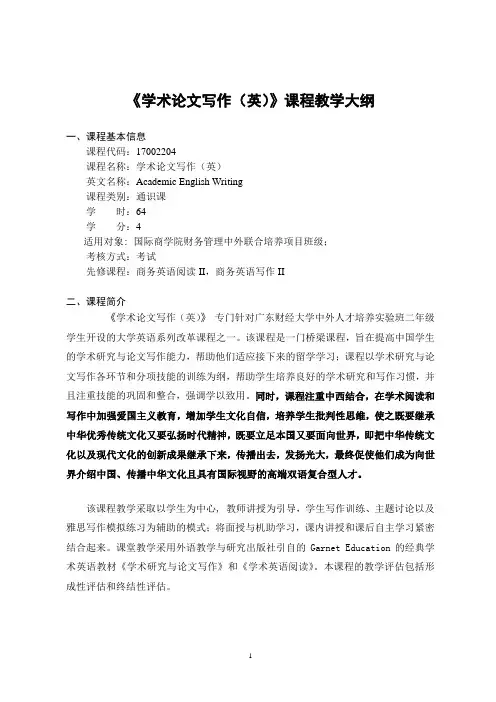
《学术论文写作(英)》课程教学大纲一、课程基本信息课程代码:17002204课程名称:学术论文写作(英)英文名称:Academic English Writing课程类别:通识课学时:64学分:4适用对象: 国际商学院财务管理中外联合培养项目班级;考核方式:考试先修课程:商务英语阅读II,商务英语写作II二、课程简介《学术论文写作(英)》专门针对广东财经大学中外人才培养实验班二年级学生开设的大学英语系列改革课程之一。
该课程是一门桥梁课程,旨在提高中国学生的学术研究与论文写作能力,帮助他们适应接下来的留学学习;课程以学术研究与论文写作各环节和分项技能的训练为纲,帮助学生培养良好的学术研究和写作习惯,并且注重技能的巩固和整合,强调学以致用。
同时,课程注重中西结合,在学术阅读和写作中加强爱国主义教育,增加学生文化自信,培养学生批判性思维,使之既要继承中华优秀传统文化又要弘扬时代精神,既要立足本国又要面向世界,即把中华传统文化以及现代文化的创新成果继承下来,传播出去,发扬光大,最终促使他们成为向世界介绍中国、传播中华文化且具有国际视野的高端双语复合型人才。
该课程教学采取以学生为中心, 教师讲授为引导,学生写作训练、主题讨论以及雅思写作模拟练习为辅助的模式;将面授与机助学习,课内讲授和课后自主学习紧密结合起来。
课堂教学采用外语教学与研究出版社引自的Garnet Education的经典学术英语教材《学术研究与论文写作》和《学术英语阅读》。
本课程的教学评估包括形成性评估和终结性评估。
三、课程性质与教学目的学术论文写作(英)是一门通识必修课,其主要目的是为我校必须参加雅思考试的中外人才培养实验班同学提供系统学习学术英语语言、培养学术论文写作能力和增强雅思写作考试技巧,同时通过大量阅读输入提高学生的学术英语素养、学术英语交流和跨文化交际能力,提升他们的批判性思维能力和跨文化交际意识。
学生学完该门课程后,应能达到以下要求:1)掌握基本学术论文写作技能,包括撰写abstract, introduction, definition, conclusion 的方法和paraphrasing 和referencing 的技巧、规范;2)掌握学术研究的基本方法,包括选题、收集和分类资料、运用论据论证观点、对论据的分析和解释等;3)学生的语篇分析和概括能力,特别是改述(paraphrase)和综述(summarise)的能力显著提升,语言表达丰富多样化;4)学生的批判性思维、西方逻辑思维和东西方文化差异意识通过写作、教师引导、和讨论得以相当的提升;提升学生在学术交流中的辩证性思考能力,能够坚定文化自信,向世界“讲好中国故事,传播好中国声音,阐释好中国特色”,进一步帮助学生树立正确价值观和加强爱国主义教育。
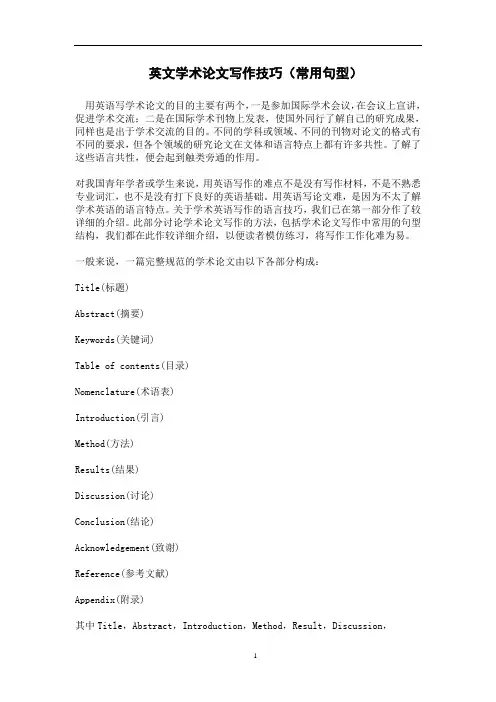
英文学术论文写作技巧(常用句型)用英语写学术论文的目的主要有两个,一是参加国际学术会议,在会议上宣讲,促进学术交流;二是在国际学术刊物上发表,使国外同行了解自己的研究成果,同样也是出于学术交流的目的。
不同的学科或领域、不同的刊物对论文的格式有不同的要求,但各个领域的研究论文在文体和语言特点上都有许多共性。
了解了这些语言共性,便会起到触类旁通的作用。
对我国青年学者或学生来说,用英语写作的难点不是没有写作材料,不是不熟悉专业词汇,也不是没有打下良好的英语基础。
用英语写论文难,是因为不太了解学术英语的语言特点。
关于学术英语写作的语言技巧,我们已在第一部分作了较详细的介绍。
此部分讨论学术论文写作的方法,包括学术论文写作中常用的句型结构,我们都在此作较详细介绍,以便读者模仿练习,将写作工作化难为易。
一般来说,一篇完整规范的学术论文由以下各部分构成:Title(标题)Abstract(摘要)Keywords(关键词)Table of contents(目录)Nomenclature(术语表)Introduction(引言)Method(方法)Results(结果)Discussion(讨论)Conclusion(结论)Acknowledgement(致谢)Reference(参考文献)Appendix(附录)其中Title,Abstract,Introduction,Method,Result,Discussion,Conclusion,Reference等八项内容是必不可少的(其他内容根据具体需要而定)。
在这八项内容中,读者最多的是Title,Abstract和Introduction部分,读者会根据这些内容来决定是否阅读全文。
也就是说,一篇研究论文赢得读者的多少,在很大程度上取决于Title,Abstract和Introduction写得好坏。
因此这三项内容将各分章详细加以讲述。
学术论文的正文一般包括Method,Result,Discussion三个部分。
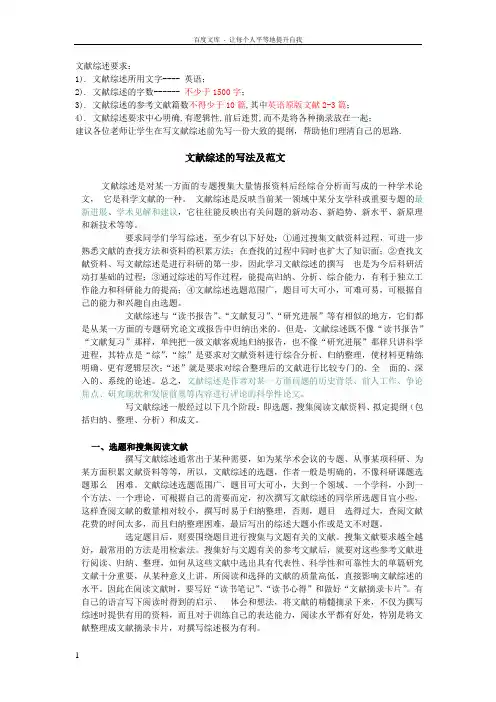
文献综述要求:1). 文献综述所用文字---- 英语;2). 文献综述的字数------ 不少于1500字;3). 文献综述的参考文献篇数不得少于10篇,其中英语原版文献2-3篇;4). 文献综述要求中心明确,有逻辑性,前后连贯,而不是将各种摘录放在一起;建议各位老师让学生在写文献综述前先写一份大致的提纲,帮助他们理清自己的思路.文献综述的写法及范文文献综述是对某一方面的专题搜集大量情报资料后经综合分析而写成的一种学术论文,它是科学文献的一种。
文献综述是反映当前某一领域中某分支学科或重要专题的最新进展、学术见解和建议,它往往能反映出有关问题的新动态、新趋势、新水平、新原理和新技术等等。
要求同学们学写综述,至少有以下好处:①通过搜集文献资料过程,可进一步熟悉文献的查找方法和资料的积累方法;在查找的过程中同时也扩大了知识面;②查找文献资料、写文献综述是进行科研的第一步,因此学习文献综述的撰写也是为今后科研活动打基础的过程;③通过综述的写作过程,能提高归纳、分析、综合能力,有利于独立工作能力和科研能力的提高;④文献综述选题范围广,题目可大可小,可难可易,可根据自己的能力和兴趣自由选题。
文献综述与“读书报告”、“文献复习”、“研究进展”等有相似的地方,它们都是从某一方面的专题研究论文或报告中归纳出来的。
但是,文献综述既不像“读书报告”“文献复习”那样,单纯把一级文献客观地归纳报告,也不像“研究进展”那样只讲科学进程,其特点是“综”,“综”是要求对文献资料进行综合分析、归纳整理,使材料更精练明确、更有逻辑层次;“述”就是要求对综合整理后的文献进行比较专门的、全面的、深入的、系统的论述。
总之,文献综述是作者对某一方面问题的历史背景、前人工作、争论焦点、研究现状和发展前景等内容进行评论的科学性论文。
写文献综述一般经过以下几个阶段:即选题,搜集阅读文献资料、拟定提纲(包括归纳、整理、分析)和成文。
一、选题和搜集阅读文献撰写文献综述通常出于某种需要,如为某学术会议的专题、从事某项科研、为某方面积累文献资料等等,所以,文献综述的选题,作者一般是明确的,不像科研课题选题那么困难。
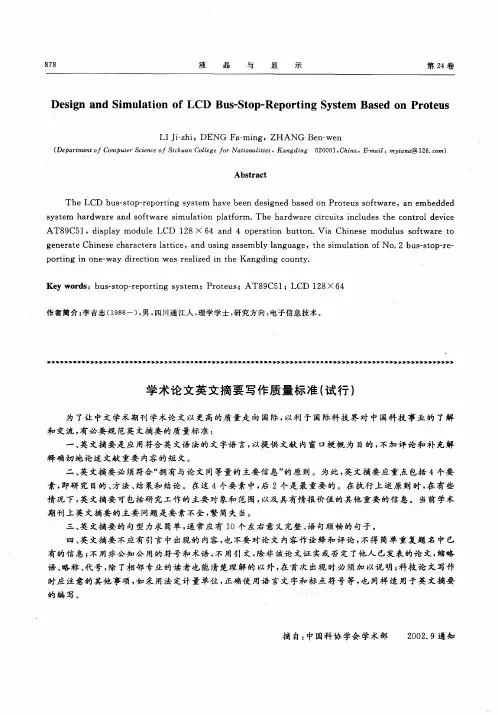
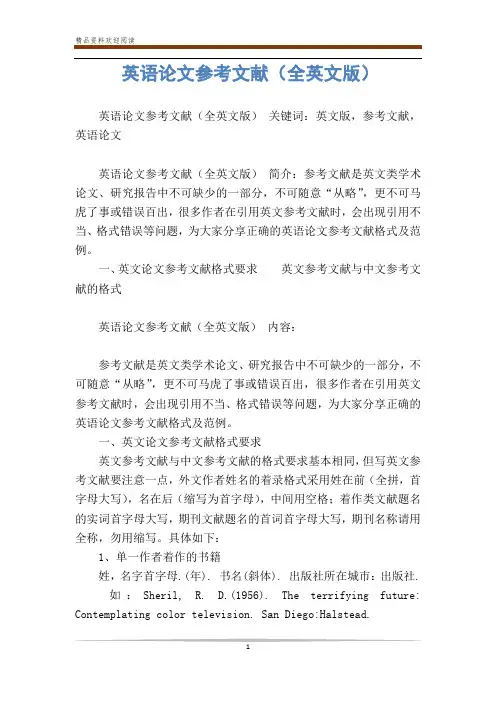
英语论文参考文献(全英文版)英语论文参考文献(全英文版)关键词:英文版,参考文献,英语论文英语论文参考文献(全英文版)简介:参考文献是英文类学术论文、研究报告中不可缺少的一部分,不可随意“从略”,更不可马虎了事或错误百出,很多作者在引用英文参考文献时,会出现引用不当、格式错误等问题,为大家分享正确的英语论文参考文献格式及范例。
一、英文论文参考文献格式要求英文参考文献与中文参考文献的格式英语论文参考文献(全英文版)内容:参考文献是英文类学术论文、研究报告中不可缺少的一部分,不可随意“从略”,更不可马虎了事或错误百出,很多作者在引用英文参考文献时,会出现引用不当、格式错误等问题,为大家分享正确的英语论文参考文献格式及范例。
一、英文论文参考文献格式要求英文参考文献与中文参考文献的格式要求基本相同,但写英文参考文献要注意一点,外文作者姓名的着录格式采用姓在前(全拼,首字母大写),名在后(缩写为首字母),中间用空格;着作类文献题名的实词首字母大写,期刊文献题名的首词首字母大写,期刊名称请用全称,勿用缩写。
具体如下:1、单一作者着作的书籍姓,名字首字母.(年). 书名(斜体). 出版社所在城市:出版社.如:Sheril, R. D.(1956). The terrifying future: Contemplating color television. San Diego:Halstead.2、两位作者以上合着的书籍姓,名字首字母., 姓,名字首字母.(年). 书名(斜体). 出版社所在城市:出版社.如:Smith, J., Peter, Q. (1992).Hairball: An intensive peek behind the surface of an enigma. Hamilton, ON:McMaster University Press.3、文集中的如:Mcdonalds, A.(1993). Practical methods for the apprehension and sustained containment ofsupernatural entities. In G. L. Yeager (Ed.), Paranormal and occult studies:Case studies in application (pp. 42–64). London: OtherWorld Books.4、期刊中的(非连续页码)如:Crackton, P.(1987). The Loonie: God's long-awaited gift to colourful pocket change?Canadian Change, 64(7), 34–37.5、期刊中的(连续页码):姓,名字首字母.(年). 题目. 期刊名(斜体). 第几期,页码.如:Rottweiler, F. T., Beauchemin, J. L. (1987). Detroit and Narnia: Two foes on the brink ofdestruction. Canadian/American Studies Journal, 54, 66–146.6、月刊杂志中的如:Henry, W. A., III.(1990, April 9). Making the grade in today's schools. Time, 135, 28-31.二、英文论文参考文献范例。
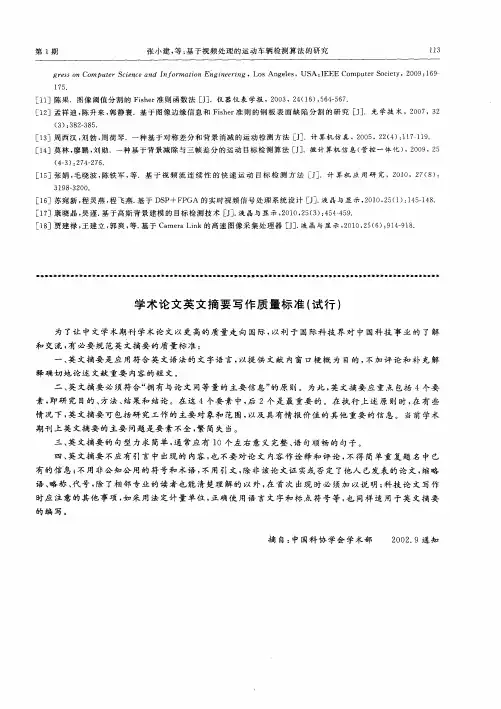

文献综述要求:1). 文献综述所用文字---- 英语;2). 文献综述的字数------ 不少于1500字;3). 文献综述的参考文献篇数不得少于10篇,其中英语原版文献2-3篇;4). 文献综述要求中心明确,有逻辑性,前后连贯,而不是将各种摘录放在一起;建议各位老师让学生在写文献综述前先写一份大致的提纲,帮助他们理清自己的思路.文献综述的写法及范文文献综述是对某一方面的专题搜集大量情报资料后经综合分析而写成的一种学术论文,它是科学文献的一种。
文献综述是反映当前某一领域中某分支学科或重要专题的最新进展、学术见解和建议,它往往能反映出有关问题的新动态、新趋势、新水平、新原理和新技术等等。
要求同学们学写综述,至少有以下好处:①通过搜集文献资料过程,可进一步熟悉文献的查找方法和资料的积累方法;在查找的过程中同时也扩大了知识面;②查找文献资料、写文献综述是进行科研的第一步,因此学习文献综述的撰写也是为今后科研活动打基础的过程;③通过综述的写作过程,能提高归纳、分析、综合能力,有利于独立工作能力和科研能力的提高;④文献综述选题范围广,题目可大可小,可难可易,可根据自己的能力和兴趣自由选题。
文献综述与“读书报告”、“文献复习”、“研究进展”等有相似的地方,它们都是从某一方面的专题研究论文或报告中归纳出来的。
但是,文献综述既不像“读书报告”“文献复习”那样,单纯把一级文献客观地归纳报告,也不像“研究进展”那样只讲科学进程,其特点是“综”,“综”是要求对文献资料进行综合分析、归纳整理,使材料更精练明确、更有逻辑层次;“述”就是要求对综合整理后的文献进行比较专门的、全面的、深入的、系统的论述。
总之,文献综述是作者对某一方面问题的历史背景、前人工作、争论焦点、研究现状和发展前景等内容进行评论的科学性论文。
写文献综述一般经过以下几个阶段:即选题,搜集阅读文献资料、拟定提纲(包括归纳、整理、分析)和成文。
一、选题和搜集阅读文献撰写文献综述通常出于某种需要,如为某学术会议的专题、从事某项科研、为某方面积累文献资料等等,所以,文献综述的选题,作者一般是明确的,不像科研课题选题那么困难。
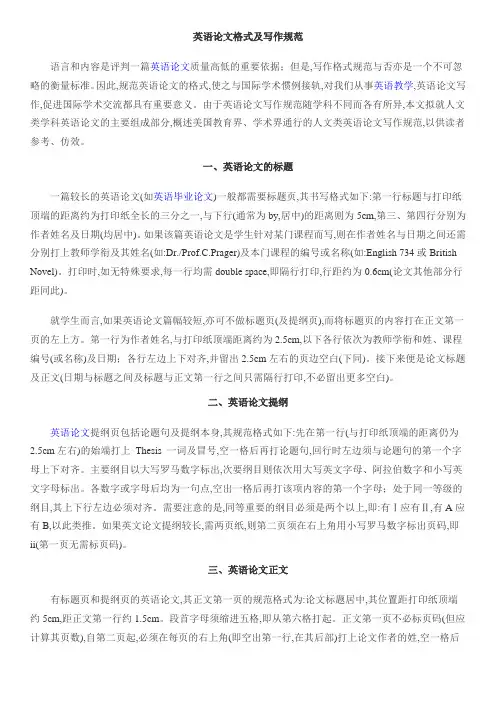
英语论文格式及写作规范语言和内容是评判一篇英语论文质量高低的重要依据;但是,写作格式规范与否亦是一个不可忽略的衡量标准。
因此,规范英语论文的格式,使之与国际学术惯例接轨,对我们从事英语教学,英语论文写作,促进国际学术交流都具有重要意义。
由于英语论文写作规范随学科不同而各有所异,本文拟就人文类学科英语论文的主要组成部分,概述美国教育界、学术界通行的人文类英语论文写作规范,以供读者参考、仿效。
一、英语论文的标题一篇较长的英语论文(如英语毕业论文)一般都需要标题页,其书写格式如下:第一行标题与打印纸顶端的距离约为打印纸全长的三分之一,与下行(通常为by,居中)的距离则为5cm,第三、第四行分别为作者姓名及日期(均居中)。
如果该篇英语论文是学生针对某门课程而写,则在作者姓名与日期之间还需分别打上教师学衔及其姓名(如:Dr./Prof.C.Prager)及本门课程的编号或名称(如:English 734或British Novel)。
打印时,如无特殊要求,每一行均需double space,即隔行打印,行距约为0.6cm(论文其他部分行距同此)。
就学生而言,如果英语论文篇幅较短,亦可不做标题页(及提纲页),而将标题页的内容打在正文第一页的左上方。
第一行为作者姓名,与打印纸顶端距离约为2.5cm,以下各行依次为教师学衔和姓、课程编号(或名称)及日期;各行左边上下对齐,并留出2.5cm左右的页边空白(下同)。
接下来便是论文标题及正文(日期与标题之间及标题与正文第一行之间只需隔行打印,不必留出更多空白)。
二、英语论文提纲英语论文提纲页包括论题句及提纲本身,其规范格式如下:先在第一行(与打印纸顶端的距离仍为2.5cm左右)的始端打上Thesis 一词及冒号,空一格后再打论题句,回行时左边须与论题句的第一个字母上下对齐。
主要纲目以大写罗马数字标出,次要纲目则依次用大写英文字母、阿拉伯数字和小写英文字母标出。
各数字或字母后均为一句点,空出一格后再打该项内容的第一个字母;处于同一等级的纲目,其上下行左边必须对齐。
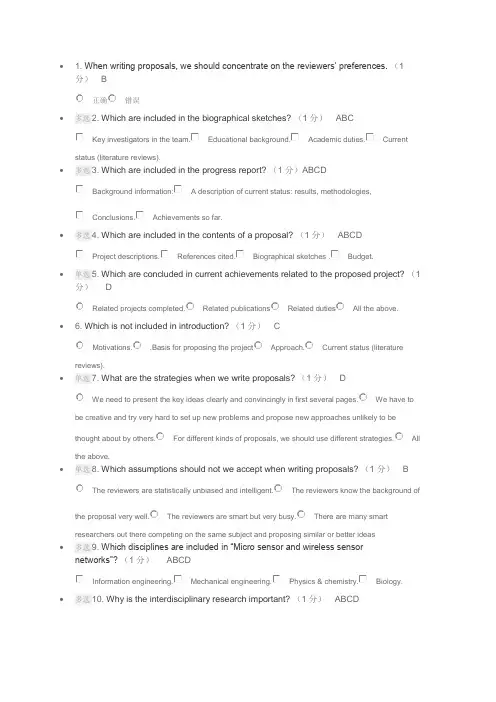
• 1. When writing proposals, we should concentrate on the reviewers’ preferences.(1分) B正确错误•多选2. Which are included in the biographical sketches?(1分)ABCKey investigators in the cational background.Academic duties.Currentstatus (literature reviews).•多选3. Which are included in the progress report?(1分)ABCDBackground information: A description of current status: results, methodologies,Conclusions.Achievements so far.•多选4. Which are included in the contents of a proposal?(1分)ABCDProject descriptions.References cited.Biographical sketches .Budget.•单选5. Which are concluded in current achievements related to the proposed project?(1分) DRelated projects completed.Related publications Related duties All the above.• 6. Which is not included in introduction?(1分) CMotivations..Basis for proposing the project Approach.Current status (literaturereviews).•单选7. What are the strategies when we write proposals?(1分) DWe need to present the key ideas clearly and convincingly in first several pages.We have tobe creative and try very hard to set up new problems and propose new approaches unlikely to bethought about by others.For different kinds of proposals, we should use different strategies.Allthe above.•单选8. Which assumptions should not we accept when writing proposals?(1分) BThe reviewers are statistically unbiased and intelligent.The reviewers know the background ofthe proposal very well.The reviewers are smart but very busy.There are many smartresearchers out there competing on the same subject and proposing similar or better ideas•多选9. Which disciplines are included in “Micro sensor and wireless sensor networks”?(1分)ABCDInformation engineering.Mechanical engineering.Physics & chemistry.Biology.•多选10. Why is the interdisciplinary research important?(1分)ABCDIn modern science and technology, there is a tendency in interdisciplinary research.It ispossible the drive forces of discipline change and development. The concepts and knowledge inone area may change the course of another area. New area may come out as the interdisciplinaryresearch.•11. Which disciplines contribute to “Quantum Informatics”? (1分) DInformation &Transportation. Information& biology.Information& chemistry.Information& physics• 判断12. If you find out there are several authors no show, you can combine the sessionwith some others”. (1分) B正确错误•单选13. In some conferences,what do you need to report to the program committee. (1分) DHow many papers are presentedAnyone no show How the session goes. All theabove.• 单选14. What are the tasks of a conference session chair ? (1分) DMeeting the authors either in author's breakfast or just before the session.Introducing theauthors.Controlling the presentation time and follow the schedule. All the above.• 判断15. If you find the paper is really interesting, can you say, "I know the paper have notbeen published yet, so I can directly use its ideas in my own paper?" (1分) B正确错误•16. To save efforts you can send emails to all the reviewers simultaneously. (1分)B正确错误• 判断17. A paper is usually reviewed by one reviewer. (1分)B正确错误•多选18. What difficulties may you meet as the associate editor or editor? (1分) ABCDYou may have difficulty in finding a proper number of reviewers. You may have difficulty ingetting reviews from a particular reviewer who already agreed to review a paper.You may have toomany papers to handle, and you cannot turn in to handle the paper timely.You may have somepersonal affairs so you don’t have enough time.•多选19. What should you pay attention to when choosing reviewers?(1分)ABCDYou should find a little more than the standard number of candidate reviewers.You shouldalign the interest of the reviewers with ours.You should not ask a person closely related to orfighting hard with the authors to review the paper.You should not ask the advisor to reviewstudents' paper.•多选20. Which factors are important to become an AE?(1分)ABCDWilling to serve without pay.Writing a good CV.Finding a good advocate.Being agood reviewer firstly.•21. What information should you give authors if you want them to revise?(1分)DWhich parts to cut.how the paper should be reorganized.How the paper should berevised.All the above.•单选22. How long should you spend on completing the review?(1分)COne week.Two weeks.Four to six weeks.Ten weeks or more.•单选23. As an AE, what information should you get after glancing over the paper?(1分)DWhat the paper about.Its potential contributions.Who are other leading researchers inthe area.All the above.•判断24. Validity or correctness of the method means whether your paper fits this conference or journal.(1分)B正确错误•判断25. Serving as a reviewer can help you develop the capability of critical reading and providing critic reviews.(1分)B正确错误•26. Which statements are correct when you serve as a reviewer?(1分)ABCGive the comments to the authors for improvement and confidential.You are advised to bespecific and constructive to the authors especially the beginning researcher.You should keepconfidentiality, and you should not disclose any information on the review of the paper.You candisclose some information on the review because the system is anonymous.•多选27. Which parts should be included in rating scales?(1分)BCDOriginality or creativity of the concept.Validity or correctness of the method.Clarity of thewriting.Suitability of the readership•单选28. Which part mainly determine the contributions of the paper?(1分)BValidity or correctness of the method.Originality or creativity of the concept.Clarity of thewriting.Suitability of the readership•判断29. When making a poster, printing out your PPT is also a good choice.(1分)A正确错误•判断30. In poster sessions, you can just leave the poster at designated area and hang out.(1分)B正确错误•31. Plenary and keynote speeches are very important because it often discusses the future development and research directions.(1分)A正确错误•多选32. What are the benefits of poster sessions?(1分)ABCDIt can attract the people who are interested in your work.You can networksomebody who is interested in your work.You can get the feedback in real time.It provides a stage for participants to communicate with each other.•多选33. Which statements are correct?(1分) ACDYou can just participate the sessions you are interested in.You mustparticipate all sessions You should ask question appropriately and make commentspolitely.You can choose one or two committee to participate.•多选34. Which activities are included in a conference?(1分) ABCDPaper presentation sessions Poster sessions Committee meetingsSocial activities•单选35. When should we meet session chair?(1分) AAt author’s breakfast or just before the session.At poster sessions.During other’s presentation.Just at any time.•36. How long should the author be allowed to present the paper?(1分)BAbout 2 or 3 minutes.About 15 to 20 minutes.About an hour.About two hours ormore.•单选37. What does “no show” mean in the video?(1分)BYou don’t submit the final paper.You submit a paper to the conference and do not show up atit.Don’t show off when you make presentation.You don’t do a good presentation.•单选38. What should you do when you present a paper?(1分)DPrepare slides strictly according to the time limit.Make presentation and answer questionspolitely.Read program carefully, locate your session and be aware the time slot for presentation.All the above.•判断39. To save efforts you can just list the one author and use “et al” for the others if the reference paper have many authors.(1分)B正确错误•判断40. There is no need to ask anyone’s consensus if I want to reuse the graph and picture from my own paper.(1分)B正确错误•41. Which statements are correct?(1分) ABCYou should treat other people’s ideas and intellectual property with respect andcare.You should respect other people’s ideas in academic exchanges.You shouldask permission for use of documents and so on.You should publish the achievementfirst when you get an idea from others.•多选42. What should we do when we treat other people’s idea and intellectual property?(1分) ABCDRespect other people’s ideas in aca demic exchanges Ask permission for use ofdocuments, etc.Pay attention to the copyright for use of graphs.Be aware of the cultural differences.•多选43. Why it is important to share credit?(1分) ABCDBecause it is the basis for free sharing the idea and respect for the intellectualproperty right of scholars.Because there is a harsh punishment for plagiarism.Because it can help to have a healthy research atmosphere.Because it can protect the right of scholars.•单选44. Which of the following is unacceptable in terms of sharing credit?(1分) DIf I want to reuse the graph and picture of my paper that has been previouslypublished, I still ask for the permission and copyright from the publisher.I have tomake sure that it is really my work before I claim my contribution in the paper.I am generous to collaborators in some cases that their contributions are not very clear cut.I claim credit in my paper but the main idea is the result of the discussion with mycolleagues.•判断45. In order to prepare a good presentation, you can record your talk and then rehearse and practice.(1分)A正确错误•46. What should you do in Q&A?(1分)ACDAnswer audiences’ questions politely.For simple questions, you can say “the question is soeasy and you should ask google”.Deflect the answer to the point you want to emphasize forirrelevant questions.Admit and/or offer the approach to finding the answer, or offer answers later if no answer•多选47. What should you do when making a presentation?(1分)ABCDDon’t re ad but present with confidence.Mention main goal early to capture attention Don'tslur your pronunciations and let sentences trail off.Try to emphasis in different ways.•判断48. In order to enhance performance, you should use slides as many as possible.(1分)B正确错误•判断49. Don’t use too many variables and notations, or the audience would forget.(1分)A正确错误•判断50. If you use a circle to represent something, you also could use it to present another thing in the same talk.(1分)B正确错误。
英文版文献综述范文英文文献综述写文献综述是对某一方面的专题搜集大量情报资料后经综合分析而写成的一种学术论文,它是科学文献的一种。
格式与写法文献综述的格式与一般研究性论文的格式有所不同。
这是因为研究性的论文注重研究的方法和结果,特别是阳性结果,而文献综述要求向读者介绍与主题有关的详细资料、动态、进展、展望以及对以上方面的评述。
因此文献综述的格式相对多样,但总的来说,一般都包含以下四部分:即前言、主题、总结和 ___。
撰写文献综述时可按这四部分拟写提纲,在根据提纲进行撰写工。
前言部分,主要是说明写作的目的,介绍有关的概念及定义以及综述的范围,扼要说明有关主题的现状或争论焦点,使读者对全文要叙述的问题有一个初步的轮廓。
主题部分,是综述的主体,其写法多样,没有固定的格式。
可按年代顺序综述,也可按不同的问题进行综述,还可按不同的观点进行比较综述,不管用那一种格式综述,都要将所搜集到的文献资料归纳、及分析比较,阐明有关主题的历史背景、现状和发展方向,以及对这些问题的评述,主题部分应特别注意代表性强、具有科学性和创造性的文献引用和评述。
总结部分,与研究性论文的小结有些类似,将全文主题进行扼要总结,对所综述的主题有研究的作者,最好能提出自己的见解。
___虽然放在文末,但却是文献综述的重要组成部分。
因为它不仅表示对被引用文献作者的尊重及引用文献的依据,而且为读者深入探讨有关问题提供了文献查找线索。
因此,应认真对待。
___的编排应条目清楚,查找方便,内容准确无误。
关于 ___的使用方法,录著项目及格式与研究论文相同,不再重复。
文学太宽泛了,你必须一点点的把你的论文论述的观点缩小,不然你写什么都不知道。
1. 去图书馆找所有与汤姆叔叔的小屋相关的所有英文资料,甚至是原文读本序言之类,也有你可以借鉴的句子。
2. 去电子阅览室,搜索所有与汤姆叔叔的小屋相关的论文评论,找到你觉得有用的拷下来。
3. 到网上搜索下相关词条,如wiki百科的英文相关词条4. 最好浏览一遍原文,看不懂的话中英文对照本也行。
英文毕业论文文献综述的写法及范文文献综述要求:1). 文献综述所用文字---- 英语;2). 文献综述的字数------ 不少于1500字;3). 文献综述的参考文献篇数不得少于10篇,其中英语原版文献2-3篇;4). 文献综述要求中心明确,有逻辑性,前后连贯,而不是将各种摘录放在一起;建议各位老师让学生在写文献综述前先写一份大致的提纲,帮助他们理清自己的思路.文献综述的写法及范文文献综述是对某一方面的专题搜集大量情报资料后经综合分析而写成的一种学术论文,它是科学文献的一种。
文献综述是反映当前某一领域中某分支学科或重要专题的最新进展、学术见解和建议,它往往能反映出有关问题的新动态、新趋势、新水平、新原理和新技术等等。
要求同学们学写综述,至少有以下好处:①通过搜集文献资料过程,可进一步熟悉文献的查找方法和资料的积累方法;在查找的过程中同时也扩大了知识面;②查找文献资料、写文献综述是进行科研的第一步,因此学习文献综述的撰写也是为今后科研活动打基础的过程;③通过综述的写作过程,能提高归纳、分析、综合能力,有利于独立工作能力和科研能力的提高;④文献综述选题范围广,题目可大可小,可难可易,可根据自己的能力和兴趣自由选题。
文献综述与“读书报告”、“文献复习”、“研究进展”等有相似的地方,它们都是从某一方面的专题研究论文或报告中归纳出来的。
但是,文献综述既不像“读书报告”“文献复习”那样,单纯把一级文献客观地归纳报告,也不像“研究进展”那样只讲科学进程,其特点是“综”,“综”是要求对文献资料进行综合分析、归纳整理,使材料更精练明确、更有逻辑层次;“述”就是要求对综合整理后的文献进行比较专门的、全面的、深入的、系统的论述。
总之,文献综述是作者对某一方面问题的历史背景、前人工作、争论焦点、研究现状和发展前景等内容进行评论的科学性论文。
写文献综述一般经过以下几个阶段:即选题,搜集阅读文献资料、拟定提纲(包括归纳、整理、分析)和成文。
apa第七版英文参考文献格式APA第七版英文参考文献格式(Creating and Expanding on the Title)APA第七版是美国心理学协会(American Psychological Association,APA)发布的一套用于学术写作和出版的规范。
其中,参考文献格式是学术论文中非常重要的一部分,它能够对文献来源进行统一的格式化,并为读者提供详细的信息以便深入了解研究。
以下是APA第七版英文参考文献格式的一些常见类型及其要求:1. 书籍(Book):姓氏,名字首字母. (出版年). 书名. 出版地: 出版社.2. 期刊文章(Journal Article):姓氏,名字首字母. (出版年). 文章标题. 期刊名, 卷(期), 页码.3. 学位论文(Thesis or Dissertation):姓氏,名字首字母. (年份). 论文标题 (学位类型). 所在大学.4. 网络资源(Online Resource):作者. (出版年). 文章标题. 网站名. URL.5. 报纸文章(Newspaper Article):作者. (出版年, 月日). 文章标题. 报纸名, 页码.除了以上常见类型,APA第七版还针对其它类型的参考文献,如会议论文、报告、电子书等,提供了详细的格式要求,请在写作过程中查阅相关指南以获取准确的信息。
要注意的是,在参考文献列表中,按照姓氏字母顺序对文献进行排序,并使用缩进格式,即第一行左对齐,后续行缩进半英寸。
参考文献列表的标题应为'参考文献'(References)。
此外,引用文献时,可以使用以下两种方式:1. 直接引用:在文中插入作者的姓氏和出版年份,如:(Smith, 2020)2. 间接引用:在文中插入作者的姓氏和出版年份,并在句末添加'as cited in',如:(Smith, 2020, as cited in Johnson, 2021)APA第七版的参考文献格式能够提供清晰、准确的信息,使读者能够轻松找到并深入了解相关研究。
学术论文写作报告(英文版)
1. Introduction
Writing an academic paper requires careful consideration of various elements such as topic selection, research methodology, data analysis, and proper citation. This report provides a comprehensive guide to academic paper writing, focusing on the key steps involved and the necessary components to include. The report aims to assist researchers and students in effectively structuring and presenting their work in an organized and coherent manner.
2. Topic Selection
The first step in writing an academic paper is selecting an appropriate topic. The topic should be specific yet broad enough to allow for thorough research. It is essential to choose a topic that is relevant to the field of study and of interest to the writer. Consideration should also be given to the availability of reliable sources and potential research gaps that can be addressed.
3. Literature Review
After selecting a topic, conducting a literature review is crucial to identify the existing research and establish the research gap. The literature review provides an overview of the current state of knowledge on the subject and helps the writer understand the key concepts, theories, and methodologies that have been used in previous studies. It also helps in formulating research questions and hypotheses.
4. Research Methodology
Once the research questions have been formulated, it is important to select an appropriate research methodology. The methodology should be aligned with the research objectives and should allow for the collection of relevant and reliable data. Common research methods include surveys, case studies, experiments, and observations. The chosen methodology should be adequately justified and explained in the paper.
5. Data Collection and Analysis
After determining the research methodology, data collection can begin. This involves gathering relevant data through various sources such as interviews, surveys, experiments, or existing databases. The collected data should be analyzed using appropriate statistical or qualitative analysis techniques. The analysis should be presented in a clear and concise manner, highlighting any significant findings.
6. Results and Discussion
The results section of the academic paper presents the findings of the research. It should be presented using tables, charts, or graphs to aid in understanding. The discussion section focuses on interpreting the results in relation to the research questions and objectives. It involves critically analyzing the findings, comparing them with previous studies, and discussing their implications.
7. Conclusion
The conclusion is a summary of the key findings and their implications. It should answer the research questions and provide insights into the broader significance of the research. The conclusion should also highlight any limitations of the study and suggest directions for future research.
8. References
Proper citation and referencing are crucial in academic writing. The reference section should include all the sources used in the paper, cited in a consistent and accurate format. It is important to follow the specific citation style required by the journal or institution.
9. Formatting and Proofreading
Before submitting the academic paper, it is important to ensure proper formatting. This includes following the guidelines provided by the journal or institution regarding font type, font size, line spacing, and margins. Additionally, the paper should be thoroughly proofread to eliminate any grammatical or spelling errors. Using professional editing tools or getting feedback from peers can be helpful in improving the overall quality of the paper.
Conclusion
Writing an academic paper requires attention to detail and adherence to specific guidelines. This report has provided an overview of the key steps involved in academic paper writing, including topic selection, literature review, research methodology, data analysis, and proper citation. By following these guidelines, researchers and students can improve the quality of their academic papers and increase their chances of success.。